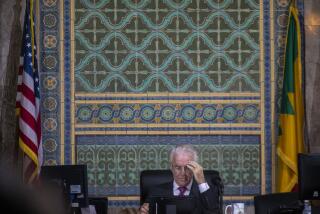Bradley Gives Lecture to City Planners : Politics: Mayor tells the department’s staff to stop being an easy mark for those seeking support for projects. Speech is seen as signaling a new direction toward development.
- Share via
Warning that “any city that does not grow will stagnate and die,” Mayor Tom Bradley said in an unusual lecture to city planners Thursday that slow-growth advocates, greedy developers and self-serving politicians are endangering Los Angeles’ ability to provide comprehensive planning.
Part of the mayor’s speech echoed the strongly held sentiments of top housing and planning aides that the city’s anti-growth movement, led by homeowners’ groups and their allies on the City Council, is beginning to threaten the economic health of the city.
However, Bradley did not stop there. He declared that both “no growth” and “unlimited growth” to be “bankrupt ideas.” He said the planning process should leave no room for those who would “build anywhere they choose for personal economic gain” and he urged planning officials to say “no” to politicians lobbying on behalf of special interests.
The mayor made his speech to a captive audience of Planning Department employees, who filled the City Council chambers after being asked to attend by acting planning director Melanie Fallon. It was the first time the mayor has addressed the department and he did not spare the rod. Much of what he had to say echoed longstanding criticism that the Planning Department, buffeted by parochial political pressures from all corners of the city, has no overarching plan for Los Angeles.
“You must be the Planning Department, not the political department and not the case processing department,” Bradley said.
Bradley told the planning staff to stop being an easy mark for politicians, whether from the City Council or the mayor’s office, who are drumming up support for particular projects.
“The worst thing that can happen is when an elected official can approach you and tie you down with a commitment before you have looked at all sides of an issue,” he said.
The mayor’s speech represented a new and different chapter in the history of the Bradley Administration’s practices and policies toward planning and development. A staunch pro-growth supporter at the outset of his tenure 20 years ago, Bradley more recently has reached out to the slow-growth movement, creating a network of neighborhood planning bodies and subjecting a greater number of proposed commercial developments to environmental review. At the same time, his Administration has frequently been criticized for intervening in the planning process on behalf of developers who were allies or contributors to the mayor.
Perhaps with that criticism in mind, Bradley told the planners to ignore special requests even when they come from the mayor’s office.
Bradley called for two kinds of growth, both aimed at counterbalancing the sprawl so characteristic of the region. He endorsed a mixed-use ordinance to provide incentives for real estate developers to intersperse apartments and condominiums with offices and stores. A throwback to eastern cities, mixed-use development can knit a city closer together, put homes and businesses within walking distance of each other and lessen the need for automobiles.
The mayor also dusted off a Los Angeles planning perennial known as the “centers concept,” which calls for increasing population in 30 or so places around the city, such as Warner Center, Westwood, downtown and Century City, where development is already dense. Members of Bradley’s staff believe that building capacity within the centers has not been fully realized because of successful efforts of neighborhood groups to rein in development.
Bradley said that the city must devote more of its planning energy to poorer parts of town that have lacked the political muscle necessary to make City Hall pay attention.
“We need planning for South Los Angeles and the Eastside,” Bradley said. He urged the department to change “past policies of allocating scarce resources only to the loudest voices.”
Overall, Bradley’s address was as much a pep talk as a policy speech; he often sounded like a coach trying to rouse his players from a slough of ineptitude and indifference. He scolded the Planning Department for taking two or three years to make recommendations on the environmental impact of proposed building projects. And he urged the department’s employees to be more responsive to people’s questions.
“When you don’t know an answer to someone’s question, don’t shine ‘em on, don’t shuffle ‘em off to someone else down the line,” he said. “Find out the answer. . . . We need to restore public confidence in this department and this city.”
Fallon said she welcomed the mayor’s remarks.
“He had some tough things to say, and I’m sure not everyone in the department was glad to hear it,” Fallon said. “But I think it made the point that the city lacks a clear direction from my office, from the (planning) commission’s and from the mayor’s.
“We have given in too much to various political whims. The mayor’s speech will make it easier for us to say no.”
City Councilman Michael Woo, a member of the council’s Planning and Environment Committee, said the mayor was right to blame members of the council for meddling in the planning process.
“We’re always hammering away at the Planning Department, trying to be first in line to get approvals for our projects,” Woo said. “Obviously, that’s got to stop if the department is going to play a more rational and less political role.”
Woo also praised Bradley for urging the department to pay more attention to East Los Angeles and South-Central, where issues of housing and economic development often go unnoticed while planners debate the merits of projects in more affluent areas.
“I knew more about horse keeping properties in the North Valley than I ever wanted to know,” Woo said.
Richard Weinstein, dean of UCLA’s School of Architecture and Urban Planning and an adviser to City Hall on planning issues, said he was pessimistic about any proposed reforms of the Planning Department that did not put the department beyond the reach of the City Council. Under the present system, said Weinstein, the council has control over the department’s budget and thus the ability to penalize it for unpopular policies.
“Citywide planning for roads or housing or economic development transcends councilmanic boundaries,” Weinstein said. “You can’t assert what is best for the city as a whole as long as you have to serve the local agendas of 15 different council members.”
The way things are now, said Weinstein, planners quickly learn they can’t do citywide planning.
More to Read
Sign up for Essential California
The most important California stories and recommendations in your inbox every morning.
You may occasionally receive promotional content from the Los Angeles Times.










